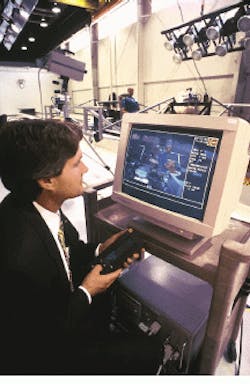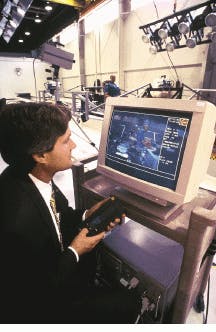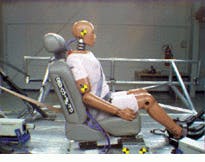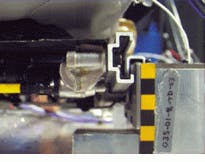Automotive suppliers use to test RESTRAINT designs
Automotive suppliers use to test RESTRAINT designs
By Randal Chinnock, Contributing Editor
The advent of digital cameras has markedly improved high-speed imaging by eliminating photographic film and manual motion calculations and analyses, providing nearly instantaneous results, and maximizing the productivity of expensive test setups. Because of these advancements, higher-reliability high-speed image-capture, processing, and display systems are being produced by military, industrial, and automotive manufacturers to test a variety of objects under high-speed conditions.
Lear Corp. (Southfield, MI), a supplier to the automotive industry, uses high-speed imaging systems to check the company`s line of seats, seatbelt-restraint systems, and interior trim components (see photo on p. 27). According to Matthew Zuzga, company development engineer, a single automotive product might require hundreds of tests during development. This led Lear to develop a $10 million test facility that is now qualifying the company`s products as well as other companies` airbags and seating components.
Unlike systems of the past that crashed cars into barriers to cause rapid deceleration, some of today`s improved automotive test systems perform controlled accelerations. To execute such accelerations, Lear`s system uses a high-gravity sled mounted on steel tracks that is accelerated by a pneumatic ram that can be charged to 3000 psi. This sled ram can be adjusted for a range of acceleration profiles, or "pulses," that are calibrated with accelerometers. To image the acceleration, as many as eight high-speed digital color cameras, capable of withstanding 100 g in any direction, are mounted on the sled.
Higher-speed imaging
In specifying its imaging system, Lear chose the EktaPro RO Imager from Eastman Kodak Motion Analysis Systems Division (San Diego, CA; see photo on p. 25). At the time, the system had one of the few cameras on the market that could withstand the required accelerations. "We were a beta site for this imager," says Zuzga. Prior to using digital cameras, Lear used the Model 1B film camera from Photo-Sonics/Instrument Marketing Corp. (Burbank, CA).
Kodak`s EktaPro RO Imager uses a 512 ¥ 384 CCD and is available in both 8-bit monochrome and 24-bit color versions with frame rates of 250, 500, and 1000 frames/s and an electronic shutter that provides exposures from 23 to 988 ms. Using internal memory, the camera can store events up to one second in duration at 1000 frames/s. Because Zuzga wanted to store portable data, he incorporated removable 110-Mbyte PCMCIA flash-memory disk cards from SanDisk (Sunnyvale, CA).
After a test event, the disks are pulled from their hard-disk drives and transferred to a Kodak 1000HRC image pro cessor that combines the luminance and chroma data from the camera and creates a TIFF file for each frame. (This PCMCIA link will soon be replaced with a 10BaseT Ethernet connection using TCP/ IP protocols to eliminate the manual handling of disk cards.) The processor, which is directed by a hand-held remote-control unit and an SVGA monitor, then stores the files on an internal magneto-optical drive and also formats them for an S-VHS output to the test control room. There, images are analyzed with a Track-Eye system from Photo-Sonics/IMC.
In operation, analysis-system software loads in the image file and prompts the test operator to key in relevant data such as lens distance and focal length. These "interest points," which were previously marked on the test object, are then automatically analyzed by the software. As the interest points move from frame to frame, the software connects the points with a line. In general, Lear only uses the software to calculate the displacement of objects in the field, although the software also can take derivatives of the line function to yield velocity and acceleration data. Accelerometers and another computer are used to derive these data.
After performing motion analysis, Zuzga downloads titles from a video titler resident in a personal computer for insertion before and after images of the test event. To ensure reliability, Lear decided not to configure the test system so that the images go through a computer to create titles overlaid on the images in order to avoid the perception that the images could be manipulated by the computer. Next, the completed titles and test event are stored on tape in either VHS or S-VHS format. A recording frame rate much lower than the event frame rate is used so that the motion of interest can be seen when played at standard tape rates.
Zuzga typically sends one tape to archive storage and one to the customer. Sometimes, he transmits TIFF or AVI loop files over the Internet to customers located worldwide. In this way, customers can view test results within minutes of completion. ©
For safety reasons, Lear personnel cannot approach the test sled until the thrust column has been depressurized and fully retracted. This means that they cannot collect the removable flash memory disks from the cameras for up to 10 minutes. During that period, the internal camera memory is copied to the flash memory disks.
Minimizing downtime
To minimize downtime, Lear has configured a preview system so that events can be viewed immediately as they are captured. Therefore, Zuzga can determine whether events have been properly captured from the system`s control room. This same preview signal also can be converted to S-VHS and recorded on tape, serving as a backup in case something goes wrong in the test area.
Gerry Locke, manager of test and development at Lear Corp., operates the Kodak EktaPro-based high-speed imaging system that is used to test automotive restraint systems.
Lear Corp.`s test system is used to check a number of automotive components including seats for General Motor`s Park Avenue vehicle. In this test, the automotive sled is fitted with a dummy. The yellow stickers on the dummy are impact targets that serve as interest points for motion analysis. Regions of interest such as the right front mount of the Park Avenue (inset) are captured with a separate camera. Engineers analyze the sequence of images to ensure that the mount flexes under stress without breaking.
Fast imaging demands high illumination
High-speed imaging requires very fast exposures. These, in turn, demand intense scene illumination. At Lear Corp. (Southfield, MI), an array of thirty-two 1000-W HMI metal-halide lamps from Osram Sylvania (Danvers, MA) are used for illumination. Producing 180,000 lux, these lamps flood the entire sled and track with intense white light with a 5600 K color temperature to match sunlight. For close-up shots, or shots in shadows, compact aircraft-landing lights are used to enhance this illumination.
To capture all the required images and to handle the g-forces on the sled, ruggedized lenses from Photo-Sonics/IMC (Burbank, CA) are used. With focal lengths ranging from 9 to 50 mm, the lenses are placed in strengthened mounts and protective cages to prevent accidental damage. Because Lear measures the captured images, these lenses are required to have low distortion so that, when coupled to the EktaPro camera with its square pixels, integration with image- or motion-analysis software ensures higher accuracy.
R. C.
Advances in high-speed imaging cameras
Eric Howard, senior engineer at Silicon Mountain Design (Colorado Springs, CO), says his customers want higher frame rates, spatial resolution, and dynamic range. To oblige, Howard`s company and others are providing camera systems that are pushing picosecond performance. For its part, the Silicon Mountain Design 4M15, 2k ¥ 2k ¥ 12-bit, 15-frame/s camera is being used for printed-circuit-board inspection, PAP-smear analysis, medical fluoroscopy, and flow-field-visualization applications.
In PC-based applications, according to Ron Farrar, president of Atlantic International Imaging (Brookline, MA), 60-frame/s progressive-scan cameras with 1k ¥ 1k ¥ 12-bit resolution represents the state of the art. Because this data rate is more than the PCI bus can continuously accept, these cameras require the use of specialized frame grabbers. And, although the 60-frame/s rate cannot capture very-high-speed events, the cameras are used in machine-mechanism and product-inspection tasks.
For very-high-speed imaging, the Cordin Co. (Salt Lake City, UT) Model 220-8 camera offers 752 ¥ 512 ¥ 8-bit resolution with speeds to 100 million frame/s. Because no single imaging sensor can run at this rate, the camera incorporates eight such devices. Due to the extremely short exposure times, the CCDs are image-intensified using microchannel plates.
The system price ranges from $75,000 to $200,000. Susan Wenger, sales coordinator at Cordin, says the company plans to offer higher-resolution cameras by the end of the year, and "some of our customers are pushing us for even higher performance."
R. C.



